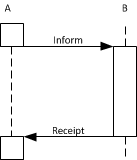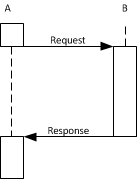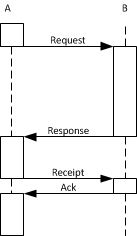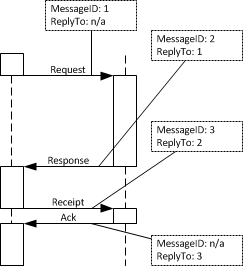Having established who is driving the integration it’s tempting to start designing the message content or turning to a messaging standard like ORIGO or FIX. However there is a layer above the message content that needs to be considered: conversation patterns. This is also a valid consideration for standards which often concentrate on the content and, whilst conversation patterns are implied or stated, it’s important to be certain about which you are using and the consequences of that choice. Don’t go mad with the number of conversation patterns for the integration, try and keep it to a small set. The following are taken from a solution I designed in 2005, which has stood the test of time:
- Inform-Receipt:
A wants to tell B something and wants B to acknowledge it has been told; A does not need any information back from B, other than the acknowledgement.
- Request-Response:
A wants some information from B. ‘Ah!’ I hear you say, ‘that’s the same as Inform-Receipt!’, well you are probably going to implement them the same way but the conversation is different: in Inform-Response B is getting something from A but in Request-Response A is getting something from B. Also note that B is not bothered if A actually got the response.
- Request-Response-Receipt
Extends Request-Response such that B now needs to confirm A has received the response before continuing.
Once you have established the conversation patterns consider a scheme for giving each message a unique identifier; this is useful for debugging problems but critical for managing idempotency and allowing for re—transmission if the connection or message is lost.
My final observation about conversation patterns is to be very clear about persisting the message before acknowledging receipt and, if possible, do this in a transaction otherwise it becomes much harder to sort out missing and duplicate message problems.
![2011.12.24 [IMG_8480]](http://www.gimeno.eu/wp-content/uploads/2013/09/2011.12.24-IMG_8480.jpg)




 Follow
Follow

